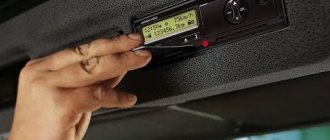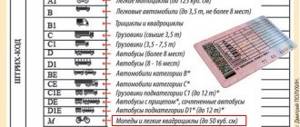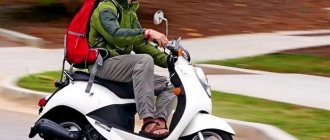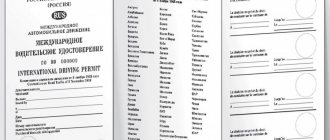Weather conditions suitable for changing tires
If you take into account only weather conditions, it is recommended to adhere to the following rules:
- dry or wet road - summer or all-season tires;
- road covered with snow - winter;
- road covered with ice - studded.
But it is recommended to install winter tires before the snow falls, also taking into account the ambient temperature. As a rule, on the tires themselves, the manufacturer independently indicates the optimal conditions for their operation - they should be adhered to. In most cases, winter tires retain their properties at temperatures of +7 °C or below, and summer tires retain their properties at temperatures of +7 °C or above.
What happens if you use summer tires in the cold? It will lose its elasticity, the tread will be excessively hard, which will cause poor grip on the road surface. And when performing a maneuver, there is a high risk of slipping or skidding.
With winter everything is a little different. At temperatures above +7 °C it becomes too soft. The grip on the road surface is excellent, but the tread wears out very quickly. Accordingly, in such conditions, tires can only be used for 3–4 months, after which their further use is dangerous.
When to change tires to winter according to Russian law
The Russian traffic regulations do not clearly indicate when tires need to be changed. There are only the following requirements:
- during the period from December to February inclusive, winter tires with the appropriate marking must be installed on a motor vehicle (vehicle);
- the use of studded tires in any period other than winter is prohibited;
- The tread pattern of the front and rear wheels must be identical;
- It is prohibited to install studded tires only on the front or rear wheels, even if the car has only one drive axle;
- the residual depth of the pattern on a winter or studded tire must be more than 4 mm; if less, operation of the vehicle is prohibited until the malfunction is eliminated.
The news has repeatedly talked about the submission of a bill to the State Duma, according to which an exact period for mandatory tire replacement will be established, but so far there has been no progress in resolving this issue.
How to correctly install tires on a car according to the tread pattern
It is important for every motorist to know how to properly install summer and winter tires on a vehicle. In the case of a non-directional tread, this is easiest to do, because the direction of rotation of the wheels is completely unimportant.
Let's consider the case of directional tires, that is, how to correctly install the tires on a car in the direction of the arrow. You need to find a mark on the rim that says “ROTATION”. This is "rotation" in English. The direction of rotation is indicated next to the arrow. It must be installed in accordance with these instructions, taking into account that the wheel rotates as it moves forward.
We recommend
“Correct installation of tires: not everything is as simple as it seems” Read more
If you want to understand why you need to comply with the requirements of the tire manufacturer, we will now try to do this. The protector is made directional for a reason. This pattern allows you to effectively remove water, slush, and dirt from the contact patch. After all, all this significantly reduces the grip of the wheel on the road. If there is no outlet, then in difficult road conditions the effect of aquaplaning is observed when the tire loses traction with the asphalt. Effective drainage using a protector avoids this dangerous phenomenon.
What tires are suitable for winter
According to current laws, in winter it is allowed to operate vehicles with the following types of tires:
- winter ones with appropriate markings;
- studded;
- all-season, if there is a marking allowing operation in winter.
However, all-season tires, as practice shows, provide poorer traction with the road surface in the cold season. At the legal level, there are no fines for their use, but experienced drivers do not recommend using them from a safety point of view.
What is the difference between a winter tire and an all-season tire? The latter has a less pronounced and branched pattern. And in composition it is more similar to summer tires; on snowy or icy roads, traction deteriorates significantly.
Rules for using winter tires
Inexperienced drivers are advised to install studded tires a little earlier than expected, when the average daily ambient temperature drops to 8–9 °C. But when the roads are completely covered with snow or ice, it is better to use studded ones. This should not be used on clean asphalt - the stability of the car decreases, and you get a kind of skating effect.
You should not skimp on winter tires, and it is better to use all four wheels. Before the first trip, you need to make sure that it is working, that is, the tread depth is suitable, the pattern is uniform, and there is no asymmetric wear.
But as for storage, the best conditions for winter tires are garage conditions, but in a dry box or room. And be sure to protect from direct sunlight.
What tires are better to use before the onset of cold weather? The best option is a winter one, but it would be a good idea to take anti-slip chains with you. But in many countries it is completely prohibited to use studded tires - if you try to go through customs, you will receive a ban.
How to change tires for winter correctly
The annual replacement of tires with winter ones, as a rule, follows a similar scenario - with the onset of frost, the first snow and ice, drivers take out their winter tires from balconies or garages and head en masse to tire centers or simply the nearest tire fitting points.
Winter is coming soon! It's time to prepare for it properly.
But will the work performed by a nameless service be of high quality and safe? How to properly change summer tires to winter ones?
Winter tires Nokian Tires and the first snow
Below are tips from Vianor's experts to ensure you've done everything you need to do to drive safely on winter roads!
Don't wait for cold weather
Drivers who experience loss of control of their car in icy or snowy conditions are frequent clients of car services. Both tire and body shops. At the same time, winter tires do not require changing them only when frost occurs. The design of winter tires is such that they begin to work effectively even at an average daily temperature of plus 7 degrees Celsius. And summer tires at this temperature already begin to work incorrectly: the rubber mixture hardens and does not provide proper grip.
Don't wait for snow and change your tires in advance based on the average daily temperature.
And don’t be embarrassed by the smiles of neighbors or colleagues who put off changing tires until the last minute - they say, “it’s too early.” All this was described in Ancient Greece by the legendary Aesop in his fable “The Beetle and the Ant,” known to us from the translation by I.A. Krylov’s remake of it by Jean La Fontaine (in the Russian version – “The Dragonfly and the Ant”). “The red summer sang; I didn’t have time to look back as winter rolled into my eyes.” It is better to make an appointment in advance at the Vianor tire center, and you will be seen at the agreed time and without having to waste precious time in line.
Check the condition of winter tires before replacing them
At Vianor tire centers, technicians carefully check the condition of winter tires brought by the client before starting replacement. In some cases, we recommend replacing the tires with new ones. In some tire shops, unfortunately, they often install the tires brought by the client on the car almost without looking - just pay the money. It is not safe! After all, there is a whole set of signs that the tires have already exhausted their service life and can seriously let you down on the road - up to the complete destruction of the tire, followed by an accident and other sad consequences.
The very first parameter of tire wear is the remaining tread depth. According to Russian legislation, for winter tires it must be at least 4 mm. You can check this not only with a caliper, but also with a simple match, the height of the sulfur head of which is 3-4 mm. When immersing the match between the tread lamellas, the sulfur head should be completely hidden from view.
Nokian Tyres tire wear indicator. If a snowflake wears off, it means the tread height has decreased to 3 mm and such a tire can no longer be used in winter, either legally or from the point of view of common sense.
Most modern tires have built-in wear indicators. Nokian Tires, for example, have a DSI (Driving Safety Indicator) wear indicator on the central tread block, which shows the remaining tread depth of the tire in millimeters. The initial tread height of new Nokian Tires winter tires averages 8-9 mm.
Tread height is not the only thing you need to pay attention to. Damage such as delamination or cracking of the tread, hernias or other damage to the sidewall of the tire clearly indicate the need for tire replacement. But if a self-tapping screw suddenly appears between the tread blocks, it can be easily repaired. The exception is run flat tires, most manufacturers of which exclude the possibility of repair.
Your attention should also be drawn to uneven tread wear - when the shoulder area is worn much more than the central area and vice versa. In such a situation, there may be options with incorrect tire pressure or “lost” wheel alignment angles - a wheel alignment may be required.
At Vianor centers, if such a service is available, they will always help you get a high-quality wheel alignment
Experts at Nokian Tires, however, emphasize that a slight difference in the nature of tread wear is acceptable, because tires on the drive axle wear out more in the central part of the tread, while in freely rotating tires the shoulder part wears out more. That is why the company recommends moving wheels from one axle to another every 8 thousand kilometers. Another recommendation from Nokian Tires is that tires in the best condition (with the least wear) should always be installed on the rear axle of the car, not the front, even if your car has front-wheel drive. Finnish experts explain this by saying that in an emergency, this will help avoid skidding of the rear axle due to loss of traction, which is much more dangerous than skidding of the front axle.
On studded tires, you should pay attention to the number of studs flying out. For example, according to experts at the Kama tire research and development center, the loss of more than 10% of the anti-skid studs, especially in one section of the tread, will no longer allow the tire to demonstrate its original characteristics. The company recommends replacing such tires with new ones. Other manufacturers have similar recommendations.
Change your tires correctly
The tire fitting process looks simple, but this is only at first glance - there are a large number of nuances that only a professional can take into account. It is not easy for an ordinary person to determine by eye the performance of tire fitting equipment or the qualifications of a technician. That's why we'll show you how a typical winter tire change takes place at one of Vianor's tire centers.
Vianor tire center in Moscow at Varshavskoye Shosse, 150
First of all, the car is installed on a hydraulic lift using high rubber buffers to prevent damage to the underbody elements of the car. Using rolling jacks is, of course, much cheaper for service, but unsafe and inconvenient.
Vianor tire centers use modern equipment
Craftsmen use a pneumatic tool to unscrew the wheels, transferring them to the washing area.
Tire washing. In the largest Vianor tire centers, one lift has its own individual wash, tire changing and balancing machine, as well as a full set of tools. This means that work can take place simultaneously at several posts.
Specialized automatic washes, which use a special shampoo, allow you to clean the wheel from reagents and other contaminants - so the client’s summer tires will be clean, and the wheels will be as prepared as possible for tire fitting work. Even a small piece of stuck dirt or bitumen can negatively affect the balance of the tire.
Removing a summer tire
After washing, the wheels are dried with compressed air and transferred to a tire changing machine. The wheel is carefully dismantled. The valve is replaced with a new one - this is not done in all tire shops, however, the poor condition of the valve is especially often the cause of a “sudden” loss of pressure in the tire.
Replacing the valve with a new one
We recommend changing valves every time you change tires - it's not expensive at all. By the way, valve replacement is sometimes included in the free tire fitting service that we offer to customers during the promotion period when purchasing a number of tire models.
The next stage: a new tire is installed on the disk, taking into account the direction of its rotation, if the tire is directional.
Installing a winter tire on a rim
The assembled wheel is then sent to a balancing machine. At the Vianor tire center on Warsaw Highway, the most modern and efficient machines are accurate and easy to use.
Modern balancing machines at the Vianor tire center
Depending on the design of the wheel rim, as well as the existing imbalance, the master installs weights of the required type and weight.
Wheel balancing
The contact surface of the spoke and the stud are cleaned and lubricated with a special lubricant. It protects the connection between the hub and the disc from corrosion and “sticking”. The wheels are pre-spun using pneumatic tools.
The so-called copper grease protects the hub-wheel connection from corrosion
Tires are set to the pressure recommended by the vehicle manufacturer. Please note that some winter tire manufacturers advise increasing tire pressure during the winter - they recommend maintaining a pressure of 0.2 Bar (20 kPa) more in winter tires than in summer tires. Pressure measurements should always be carried out on cold tires.
Tire pressure is set at Vianor centers using a high-precision pressure gauge
The last stage, if you don't take into account the careful packaging of summer tires in branded bags and then into the client's trunk, is the final tightening of the wheel nuts. This process is carried out with the car standing on the workshop floor strictly using a torque wrench adjusted to the correct tightening torque.
Hand tightening all wheel nuts with a torque wrench is very important.
This eliminates two possible serious problems at once - overtightening of the studs, and, conversely, insufficient tightening of the threaded connection. The first option can lead to the stud breaking, the second - to the loss of the wheel while moving. When performing tire fitting work at Vianor tire centers, you will not encounter such problems.
Use new tires carefully
To extend the life of new winter tires installed on your vehicle, we recommend avoiding sudden acceleration, braking and turning, as well as driving at high speeds for the first 500 kilometers. This is especially important when using “studs” - the stud seats on most of these tires are designed in such a way that for the final “fitting” of the tire stud, it is necessary to “roll” it in order to avoid premature loss of the studs.
You can get into an accident on a slippery road even with good tires, if you do not take into account the decrease in the level of grip on the surface, exceed the speed, do not keep a distance and make dangerous maneuvers. We encourage careful driving all year round.
Careful driving after tire installation carries another hidden meaning - adapting your driving style to the road conditions that have changed after cold weather. Most so-called “tinker days” occur for two reasons - the driver putting off changing tires until the last minute, and the loss of winter driving skills, which imply a significantly lower base level of grip.
Store summer tires correctly
Unfortunately, not all car owners realize that storing winter tires on the balcony is not the best possible idea. Temperature changes, direct sunlight and storing dismounted tires in a stack can quickly deteriorate even the best tires.
Proper storage of tires looks like this: tires without rims are stored on a rack or a special wooden stand; Once every two weeks they must be turned 90 degrees (a quarter turn) to protect them from deformation. Long-term storage of tires in a stack or hanging form is unacceptable. Complete wheels, on the contrary, cannot be stored standing - only in a stack or hanging. When stored in a stack, tires must be rotated once a month.
Tires must be kept clean; a special tire preservative may be used. Tires should be stored in a cool, dry place at a temperature between 0 and 15 degrees Celsius. Avoid exposure to direct sunlight and moisture, and place tires near heating radiators. To achieve optimal conditions and, accordingly, maximum tire service life, you can use the seasonal tire storage service offered at Vianor centers. By the way, here you will find not only tires, but also everything you need to operate your car in winter.
Assortment of goods in the Vianor center
Change your winter tires correctly with Vianor, and your winter driving will be stable and safe!
Photos were taken at a tire center in Moscow, Varshavskoye Shosse, 150
Tips for installing winter tires
When is the best time to install winter tires? The generally accepted “folk” date is November 15. But this is only relevant for regions located in the temperate climate zone. Otherwise, they are guided by weather conditions and the average daily ambient temperature.
Before installing winter tires, it is recommended to have the wheels balanced. It is even better to carry out maintenance of the entire suspension.
You should also give preference to stamped steel disks - they do not get clogged with snow so quickly. It is advisable to install protective plastic caps of a closed type.
Thus, the car should be “shoeed” according to the season. Not because a fine may be issued for violating this rule, but for the safety of the road user himself. But there are no all-season tires suitable for use in the Russian Federation. Scientists have not yet been able to develop rubber that would retain its same elasticity at temperatures from -30 to +80 °C.
How to correctly install tires on a rim according to the marks
When buying tires, many people paid attention to the various color marks on their surface. However, only a small number of motorists know their correct meaning. Moreover, these icons, applied with paint, are quickly erased during use of the product. Therefore, information is only available until the tires are installed on the rim. Let's review the main types of tags used in our time.
- Yellow dots or triangles
Manufacturers indicate the lightest point of the tire with a yellow marker in the form of a circle or triangle on the side surface. The diameter of the paint spot is 5–15 mm. During installation, this mark must be aligned with the L icon on the disk. If such a symbol could not be found, you need to place the mark on the tire opposite the air valve (nipple). By following these simple recommendations, it is possible to assemble the most balanced wheel, which is much easier to balance. - Red dots and triangles
The red mark indicates the hardest part of the tire. In this case, stiffness also means more weight. This mark must be positioned correctly when installing a tire. You need to align the icon with the nipple or the letter L on the disk. In this case, the letter L denotes the lightest place on the disk. Most often, red icons can be found on tires from the original set of the vehicle. The rims that come with a new car have white dots that must be positioned opposite the red mark on the tire.There is one more very important addition that all drivers should know. To correctly install the tires, when performing this operation yourself, you should be guided by the yellow marks - and they should be located opposite the nipple. You can ignore the red dots, as they serve to ensure the correct installation of the wheels in a factory assembly line.
- White circle or dot
It is common among tire manufacturers to use a white mark. This sign is intended for car assemblers. It indicates the location of minimum radial force deflection. That is, this is the most flexible part of the tire sidewall. During wheel installation, such a mark is aligned with the letter L on the disk or placed near the top mark of the wheel.











